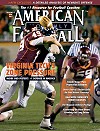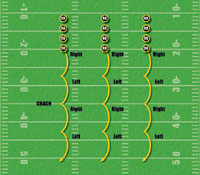AMERICAN FOOTBALL MONTHLY THE #1 RESOURCE FOR FOOTBALL COACHES
Article CategoriesAFM Magazine
|
The Drills Report: Ball Security Drillsby: David BeaudinRunning Backs Coach, American International College © More from this issue At American International College, through the diligence of our staff and head coach Art Wilkins, the idea of ball security and turnover margin is given our top priority. We have been taught to view this statistic as second only to the score of the game. Also, I have been extremely fortunate to coach talented players with high character and the ability to work hard and buy into our principles. In this article, my objective is to share my beliefs on ball security as it pertains to running backs, from both a technical and philosophical standpoint. Strategy First, the way in which we ‘talk’ about holding onto the football is something extremely important to me. Those who are familiar with psychology, either sports related or not, will tell you that the human brain tends to register positive sentences or the positive words and parts of the sentences as opposed to a negative word or statement. For instance, you will never hear me pronounce, “We will NOT drop the football.” Experts in psychology believe that, subconsciously, one would be more apt to respond to a positive sentence. Consequently, I prefer using all positive words such as “We WILL hold onto the football.” This may seem minor, and perhaps it is, but I feel a positive mind-set can only help. It’s especially important around our group because of how often it is talked about. For our group, positive words create a sense of power and we feel that a player left with a negative thought will only increase the chances of a negative action. Repetition is also important to our group, so we talk about ‘holding onto’ the football, even to the point that they are driven crazy. I want them to be obsessed with ball security. Contrary to our stance, some feel that never mentioning ‘dropping the football’ is the way it should be approached. Rather than not saying anything, for fear of creating a negative thought, we repeat and repeat the idea of powerfully holding onto the ball. We take this approach of constantly talking about security and put it into practice by relentlessly drilling it every day. As a consequence, it is talked of and drilled so much that it is not actively contemplated by our players, but rather it becomes a force of habit and builds a high level of confidence. Our drills derive from a basic premise: simply put, we continually generate awkward body positions that can and will occur in game situations; that is, all while maintaining proper ball security. We also teach never switching the ball in traffic, but only switch when we reach the second level of defenders and are in open space. We always keep the ball away from the defense by carrying the ball in our right arm while running to the right and vice versa. Drills Throughout our drills, it is commonplace to see a number of AIC running backs yelling ‘fumble’ and diving for the football if it ever hits the ground. Since our running backs are constantly reminded of the importance of security, they will all instantly react whether or not they were the one who mishandled it. In each of the drills, we try to begin with a handoff because, clearly, backs do not start a football play in a high and tight position. Therefore, we try to increase simulation by having an exchange whenever we can. These are our ‘everyday drills.’ We will mix in others depending on the time constraints of practice, our needs, and time of year. However we get it done – whether it’s before, during or after practice – and we will ALWAYS complete at least these drills on every practice day. Exchanges (Diagram 1) First, our RB’s will form a straight line in a position ready to take a handoff. I will then go down the line of backs, one at a time, placing the football in each stomach. Each back will take the handoff and only advance two steps and return to the original line. In this drill we are looking for the backs to have their head and eyes up and facing forward, a large pocket with the elbow high, and making sure they are getting a feel for rolling over the top of the ball and not reaching for it. The backs will then snatch the ball into a high and tight position, sink their hips and come out two steps. This is then repeated in the opposite direction.
Zig-Zag (Diagram 2) This is a conventional cutting drill, having the waves of backs cut at 45 degrees in the direction that the coach points. The focus is on watching the backs as they cut, making sure they have the ball in the outside arm, properly secured and appropriately bringing the opposite hand over the top with each cut. This is done down and back for approximately 20 yards and four cuts each direction, with a proper exchange.
Po-Go (Diagram 3) In this drill, the first wave of backs starts by putting the hand on the ground without the ball along with the leg on the same side. So, if the RB starts with his right hand and right foot, his left arm will properly secure the ball. He will then spring up and land on his left hand and leg, after switching the ball in the air before landing. He will continue this ‘po-go’ for 15 yards, and do the same as he returns back to the starting point, handing the ball off to the next back. This is a drill mainly for balance and can simulate getting tripped up and gaining extra yardage. The bonus is that we make sure the ball is still properly switched and secured, given the difficulties. In a similar drill we also combine having our RB’s take a hand-off and touch down twice on command, putting pressure on the hand and bursting ahead for ten yards.
Ball Wrestling (Diagram 4) The first wave of our RB's steps forward and faces the next group. After giving a handoff to the RB in front of them, they start to wrestle the ball from the RB, who holds it in one arm. This is done from the front and back for both arms. After this is completed, the back takes off running. At this point, we send a back at a random time to run from behind and slap, punch and pull on the ball. We do not allow the chase man to run alongside the back to increase the element of surprise. We also do not allow the backs running with the ball to cover up with the opposite arm. This is then repeated with the opposite arm.
Up-Down (Diagram 5) Generally, my feeling for up-downs in football is that they are typically unproductive. However, in the area of ball security, they can serve an important purpose. The backs usually do two ‘up-downs’ with the ball secured, and then burst ten yards, repeating with the opposite arm on the way back. Our focus is on keeping the ball tight even when falling to the ground. When we lost our only fumble of the last campaign by relaxing just a bit on our way to the ground, this drill became an intense focal point. We never fumbled again.
Gauntlet (Diagram 6) Our gauntlet drill is set up as follows: the RB first blasts through two hand-shields while protecting the football, and then a staggered row of players on each side slap at it. Finally, I will stand at the end with a stand-up dummy for the players to spin off. Using our opposite arm to create separation, we make sure that we initiate the spin as soon as contact is made and make certain that we are spinning AWAY from the bag and therefore not exposing the ball to the tackler.
|
|
| HOME |
MAGAZINE |
SUBSCRIBE | ONLINE COLUMNISTS | COACHING VIDEOS |
Copyright 2024, AmericanFootballMonthly.com
All Rights Reserved










